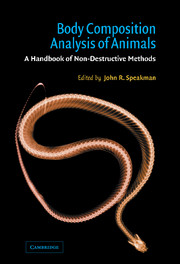Book contents
- Frontmatter
- Contents
- List of contributors
- Preface
- Acknowledgements
- Introduction
- 1 Morphological indicators of body condition: useful or wishful thinking?
- 2 Standard methods for destructive body composition analysis
- 3 The isotope dilution method for the evaluation of body composition
- 4 Gas dilution methods: elimination and absorption of lipid-soluble gases
- 5 The use of total body electrical conductivity (TOBEC) to determine body composition in vertebrates
- 6 The use of bioelectrical impedance analysis (BIA) for estimation of body composition
- 7 The assessment of body composition and other parameters by ultrasound scanning
- 8 The use of dual-energy X-ray absorptiometry for the measurement of body composition
- Index
2 - Standard methods for destructive body composition analysis
Published online by Cambridge University Press: 19 January 2010
- Frontmatter
- Contents
- List of contributors
- Preface
- Acknowledgements
- Introduction
- 1 Morphological indicators of body condition: useful or wishful thinking?
- 2 Standard methods for destructive body composition analysis
- 3 The isotope dilution method for the evaluation of body composition
- 4 Gas dilution methods: elimination and absorption of lipid-soluble gases
- 5 The use of total body electrical conductivity (TOBEC) to determine body composition in vertebrates
- 6 The use of bioelectrical impedance analysis (BIA) for estimation of body composition
- 7 The assessment of body composition and other parameters by ultrasound scanning
- 8 The use of dual-energy X-ray absorptiometry for the measurement of body composition
- Index
Summary
Introduction
Body composition analysis can provide insight into many aspects of an animal's physiology, ecology, and life history. Historically, this analysis has required sacrificing individuals to obtain accurate estimates of body composition. Recent advances in technology and innovative approaches towards developing non-destructive relationships have begun to advance our understanding of body composition without sacrificing individuals. However, these new approaches must still be validated for both accuracy and precision using direct measurements. The purpose of this chapter is to present standard methods for body composition analysis, point out some of the problems encountered when attempting to analyse body composition, and provide guidance for avoiding some of these problems
Statistical issues when measuring body composition
Body composition is a dynamic variable that often shows a high level of variation. When it has been studied, variation in body composition has been found at the level of the individual, population, and species. Although body composition analysis has been used at these three levels, most studies have focused on differences in body composition within a population. Sources of this variation can be both intrinsic (such as age, sex, or reproductive state) and extrinsic (such as climate or resource availability). In addition to natural variation, techniques used to study body composition may also introduce measurement error. Variation, irrespective of the source, must be controlled as much as possible in studies of body composition. Regardless of the taxa being investigated, several steps should be taken to account for natural variation and minimize experimental error.
Sample size
When planning an investigation, the question of an appropriate sample size is crucial.
- Type
- Chapter
- Information
- Body Composition Analysis of AnimalsA Handbook of Non-Destructive Methods, pp. 39 - 55Publisher: Cambridge University PressPrint publication year: 2001
- 32
- Cited by



